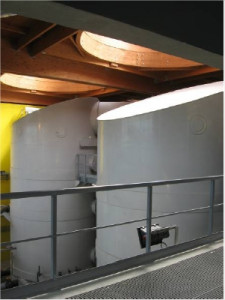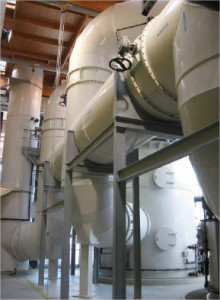Employees working in a large Waste Water Treatment Plant (WWTP) are inspecting the unity of nitrification / denitrification around 17:30 when they discover a leak of bleach (Na ClO) on a 10 m³ tank feeding one of the four deodorizing unit. The containement basin is already filled with 3 cm of bleach, they warn their superiors and the safety service. At 17.50, this service restrict the access to the room containing the tank and establish regular inspection shifts. Some employees try to seal the leak located in the lower part of the manhole at the bottom of the tank. A strap drain is enventually placed, limiting the leak to 2 m³ / day. The next day, the bleach in the containment basin is pumped into the inlet channel of the unit (flow rate 13 m³ / s) where it is highly diluted, thus avoiding distrurbance of the biological process. 5 days after the accident, an external company pumps the bleach in the basin. All the bleach recovered is eliminated in a specific facility. A specialized company analyze the tank to discover the cause of the leak and to find a repair solution. Specific containers of bleach are brought to feed the deodorizing unit until the repair is made. According to the station operator, the amount of bleach lost is around 1.6 t and no impact on people or the environment are detected.
8.1 m³ of bleach had been loaded in the tank a few hours before the discovery of the leak. The operator checks the other storage capacities of the unit (containing deodorizing products such as sulfuric acid, soda, sulfite) and a study for modernizing these capacities is launched. A procedure for emptying and disposing chemical product in case of emergency is designed by the unit staff in collaboration with the station safety service.





